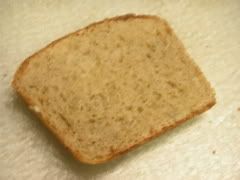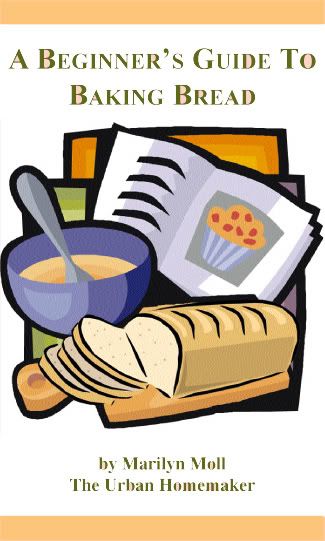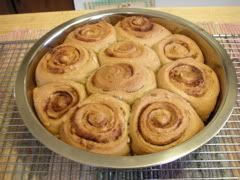Bread Baking Problems and Solutions – Here are pictures of bread baked by me in our 8″ bread pans. It makes excellent sandwiches that hold together. I used Marilyn’s Famous Whole Wheat Bread Recipe.


Q. How do I get my bread to be suitable for making sandwiches?
A. There are three basic principles for making bread good enough for sandwiches.
1. Add 1/3 to ½ cup vital wheat gluten to a 2 loaf batch of bread. Make sure the gluten is fully developed. Vital gluten makes the bread softer, moister and it rises better.
2. Make sure you don’t add too much flour – this leads to dry, crumbly bread when it cools. The dough should be smooth and elastic and a tiny bit tacky, not dry when shaping your loaves.
3.Don’t over rise the bread – coarse texture leads to crumbly bread.
Q. Is it really cheaper to make homemade bread?
A. Cost isn’t the only factor to consider when determining if bread baking is a good thing for your family. Consider the wonderful aroma in your home from home baking, and the superior nutritional value. I am glad that my homemade bread contains ingredients that I recogzine and I know how to pronounce them. Home baked bread has superior taste, and the fact that home made bread is very easy to incorporate into my routine is an added bonus. It is an added benefit to bless friends and neighbors with home baked bread.
Q. What is sponging and is it necessary?
A. Sponging is the process of allowing the yeast, water and a portion of the flour to be mixed together for about 15 minutes to activate the yeast. You could consider sponging a short, first rising. All yeast bread baking is flexible, however, and you can skip sponging and allow the bread to rise once or twice before baking. Be sure to get all the air bubbles out of the dough before shaping the loaves. Bread can rise just once in the pans before baking if you are running out of time. Conversely, bread can rise multiple times before shaping, rising, and the baking. Each rising period will improve flavor and texture. Be flexible and allow baking to fit around your schedule.
Q. I have some yeast bread recipes that do not call for fresh milled flour. How do I adjust the recipe?
A. I substitute cup for cup, whole grain hard wheat flour for all purpose flour in yeast bread recipes that appeal to me. The only adjustment I make is adding some vital gluten so the bread will not be too dense or heavy or dry.
Q. Can I use my fresh ground flour for cookies, pancakes and muffins?
A. Use freshly milled soft wheat flour or pastry wheat for any baked goods that do not contain yeast.
Remember freshly milled pastry flour must be packed like brown sugar for accurate measurements. You can obtain more information about ingredients and how to use them.
Q. My bread doesn’t rise very well.
A. Whole grain bread will not rise as well as white bread, but if you have waited several hours and the bread hasn’t doubled in size, the problem most likely is the use of low protein wheat. Low protein means low gluten content. All wheat is not created equal, and premium wheat will have a higher protein content than less expensive wheat.
Use 1 Tbsp. vital gluten per cup of flour as a starting place.
Q. I have some older yeast and I don’t know if it is still good. What do I do?
A. Proofing the yeast is a way to determine if your yeast is still good. If it isn’t, your bread may not rise well. If you suspect your yeast is out of date or old, here is how to proof (test) the yeast:
Add 1 tsp. yeast, with 1/2 cup warm water (85°F) and 1 tsp. sugar. If the yeast isn’t bubbling up to the top of the cup within 10 minutes, replace the yeast.
Be sure to store yeast cool and dry. Use moisture/vapor proof containers.
The above information has been excerpted from A Beginner’s Guide to Baking Bread ebook by Marilyn Moll. 
Click Here to purchase this ebook for $9.95. You may also obtain this book complimentary with any purchase of $75.00 or more by request.
This ebook Includes:
* How to Select Ingredients
* Selecting a Grain Mill
* Selecting A Mixer
* Step-by-Step Mixing Instructions
* How to Develop the Gluten
* Tips for the Best Bread
* Lots of Bread and Roll Recipes
* Troubleshooting Guide
* The Two-Stage Process
Item #6059 $9.95

Marylin, I n reviewing your recipes there are other ingredients that you use.
Such as, a dough enhancer. I would like to know why you use this and what is the benefit to using this.
Thank you, Tina Ivester SC Bread maker!
Hi Marilyn! I was reading some of your bread baking tips and had never been told to pack my freshly ground pastry flour like brown sugar when I measured it. I had noticed how much fluffier & lighter it was and I had read that 1 cup of flour weighs 5 oz so that is how I dealt with the difference, just weighed it out (& it always was more than 1 cup) anyway, thanks for that tip. There is always something new to learn isn’t there?
Blessings on your day, Sheree Slagle
Thanks Marylin, I have been using 2 tbs to 4 cups by weight volumne and now will try 4 tbs.
Hi Marylin,
could you please tell me why, or how to make loaf bread that doesn’t have a hole in the middle.
thank you so much.
I have a Pullman pan that I really would like to utilize but my bread never rises to the top? Have you ever used such a pan?
Thanks
Keeping in mind that trying to get your fresh milled whole wheat bread to hold up like the lifeless white bread in the store is like comparing apples to oranges….. There are a few more things you can do to hold it together better. All of Marilyn’s tips are absolutely correct, but to please my picky, used to eating white bread family, I replace a little of the water with buttermilk & then I add two beaten eggs after I sponge the bread & when I add the rest of the remaining flour. This bread seems to hold together a little better & I don’t have complaints about their sandwiches falling apart. Also, when you are milling your flour, mill some of it in a finer texture – that helps keeps things together also! Happy baking!!
Hello,
Sometimes when I make bread it comes out beautifully. But sometimes it rises like it should and when its time to bake, in the oven it will be fine for about 10 to 15 minutes, then it kind of slumps down. Almost like a popped balloon.
What can be happening?
Cynthia,
The Bread that “slumps” Has over risen. I have noticed to put my bread in the oven just after it has risen over the top of the pan then it does nicely.
If the bread Rises too Far it will surely fall. Also…If I quick rise I almost always have trouble with it falling.
Diane,
Make sure that when you shape your loaf as you roll it together be sure to seal all the seems. and then roll it like a log to lock it all togther.
Tina
I am so glad that you all are willing to take the time to write some advice. I am just about ready to give up making bread! It’s coarse, flat and doesn’t even taste very good. I’ve been making bread for years, switching to freshly milled flour in the last 5 years, but have never struggled as much as lately. Do I have a “bad” batch of grain? I bought new yeast, so that’s not the problem. I may be over rising, I’ll work on that. I can’t put milk in it because one of my kids is allergie to dairy. I think I will try the eggs. Any other suggestions?
Karen, the first thought that comes to mind is…. is your wheat hard wheat? I had once ordered some hard white wheat & what I actually recieved was a mixture of soft or pastry berries & a few other grains. At first I didn’t notice & milled & baked my bread as usual, then the bread was flat & reminded me of saltine crackers, really heavy too. I have learned that not all ‘wheat’ is created equal, it may very well be your wheat. Are you sponging first? If so, you won’t need to let it rise in the pan for too long. I sponge, mix the rest of the flour in, knead the dough, make it into loaves, put it in the pans, let it rest about 15 – 20 minutes, then bake.
I have dealt with the problem of crumbly sandwich bread by a different method. I ad honey, olive oil, molases, and eggs to the recipe to give it more “stick”. It works well if eaten within about 3 days, thereafter it begins to dry out (however Wyoming is very dry to begin with), that is when I make it all up into French Toast that can easily be reheated for a quick breakfast.
Hi. I have been adding 1/2 C of ground GOLDEN FLAX seed to my 100% WW bread and YUMMY it is ! It’s been such a hit that I can hardly keep up some weeks in bread baking ! =) It does at times get a bit too sticky though. It’s perfect most all the time.
I haven’t made loaves in years, but we still eat homemade sandwiches, and they don’t fall apart at all. I roll all the dough out on the table, about 1/2 an inch thick. Then I use a pizza cutter to cut it into squares about 3″x3″ or 4″x4″. (I’m afraid I’m not very consistent. The littleist people get the smallest ones, Daddy gets the biggest! And some are triangles!) By the time they rise and are cooked, the biggest ones are just the right size, when split, for sandwiches. This also leaves you with the smooth exterior–less crumbly mess. A batch of dough which would make 6 loaves makes 4-5 dozen “buns”. I also add 2.5 T. lecithin, which I heard helps make it chewy. May the Lord bless your bread!
HELLO,
I AM TRYING TO MAKE “JAMAICAN HARD DOUGH BREAD” I HAVE THE FLAVOR, 5 MINUTES AFTER REMOVING THE BREAD FROM THE OVEN, THE BEAUTIFUL CRUST BECOME WRINKLIE AND SHRIVLE UP.
HELP WHAT IS CAUSING THIS.
THANK YOU,
STEPHANIE
My bread crust gets too dark and I am using a convection oven so I can’t cover it towards the end of baking cycle. I am using a lower oven temperatue already – 375 vs 400.
Any suggestions?
I would like to know how to incorporate kamut flour into your whole grain bread recipe. is it possible to get a good soft sandwich bread when adding kamut?
thanks
A good substitute for egg or milk is a tablespoon or two of ground flax seed meal wisked well into equal amount of water. This will have just the same effect as putting in an egg or some milk, but doesn’t usually cause any allergic reactions. Also, ground flax seed meal is very good for you.
Ahh, Kamut flour! What a wonderful thing it is! I’ve used home ground Kamut in all breads, waffles, pancakes in straight one-to-one substitution. Allow me to quote from my pasta maker’s instructions:
“Kamut four makes an outstanding whole grain pasta which is superior to other whole grain patas in texture and is superior to semolina pasta (durum) in flavor.
“Kamut wheat also possesses a superior nutritional profile: being about 30% higher in protein, higher in 8 of 9 minerals, and 30% higher in vitamin E than common wheat. Another outstanding characteristic is that it is far less allergenic than common wheat for people suffering from allergies (see your doctor).” Quoted from the K-Tec Kitchen Champ instruction book.
I’ve never had a problem with baking bread until now. I’m just about 66 and in poor health and because of my health I can no longer kneed bread by hand like I’ve done all my life, because the wife and I have always liked home made bread and buns etc. I broke down and bought an expensive stand mixer with doe hook and all the other gadgets so we could continue to enjoy home made bread etc. I haven’t had a good batch of bread yet and we have made 3 or 4 batches. One batch I just threw in the garbage. The bread doesn’t taste the same it’s all texture and falls apart and the flavor just isn’t the same as when I made it by hand.The only thing different is I’m making smaller batches. We still use butter, bake-a-pan yeast,salt,sugar,etc.,etc. Instead of using 12 to 15 cups of flour we use 5 to 5 and a half cups and everything else is less also. So if someone knows what is wrong with what I’m doing please let me know, because it’s driving me nuts trying to figure it out.Thank You lennugent@msn.com
I would like to find a source for solving my problem My bread flops as soon as I put it in the oven.
When bread falls or sinks it usually means the bread has been over raised and the structure is weak, hence it flops or falls.
The solution is to only raise the bread until it doubles in size, shorten the rising time, raise the bread more slowly.
The first time ever that searched Google for questions and actually got an interesting answer. Thanks!
I sometimes have a problem with a baked bread either free form or loaf shapes. After it cools it will shrink. What causes this problem? The texture seems to not suffer, but the size of the product does change. The crust is not cracked and there are no large holes in the structure. I will appreciate an answer. Thfank you,
Lois Nelson
Baked products do lose some weight while baking due to dehydration, but it’s not something you can usually see by just looking. Try baking your bread 5 or 10 minutes longer until there is a nice brown crust; it will feel hard when you first remove it from the oven, but will turn soft as it cools. I hope this helps!